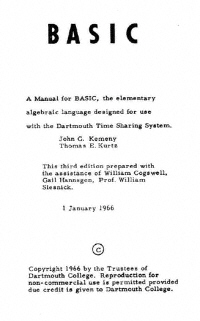|
|


 IBM System/360
IBM System/360
|
|
Computers
IBM announced the System/360, a family of six mutually compatible computers and
40 peripherals that could work together. The initial investment of $5 billion
was quickly returned as orders for the system climbed to 1,000 per month within
two years. At the time IBM released the System/360, the company was making a
transition from discrete transistors to integrated circuits, and its major
source of revenue moved from punched-card equipment to electronic computer
systems.

|
|
|
 BASIC manual
BASIC manual
|
|
Software & Languages
Thomas Kurtz and John Kemeny created BASIC, an easy-to-learn programming
language, for their students at Dartmouth College.

|
|
|
|
|
Networks
Online transaction processing made its debut in IBM's SABRE reservation system,
set up for American Airlines. Using telephone lines, SABRE linked 2,000
terminals in 65 cities to a pair of IBM 7090 computers, delivering data on any
flight in less than three seconds.

|
|
|
 CDC 6600
CDC 6600
|
|
Computers
CDC's 6600 supercomputer, designed by Seymour Cray, performed up to 3 million
instructions per second -- a processing speed three times faster than that of
its closest competitor, the IBM Stretch. The 6600 retained the distinction of
being the fastest computer in the world until surpassed by its successor, the
CDC 7600, in 1968. Part of the speed came from the computer's design, which
had 10 small computers, known as peripheral processors, funneling data to a
large central processing unit.

|
|
|
 JOSS configuration
JOSS configuration
|
|
Networks
JOSS (Johnniac Open Shop System) conversational time-sharing
service began on Rand's Johnniac. Time-sharing arose, in part, because the length of
batch turn-around times impeded the solution of problems. Time sharing aimed to bring
the user back into "contact" with the machine for online debugging and program
development.

|

|
|

|
|
